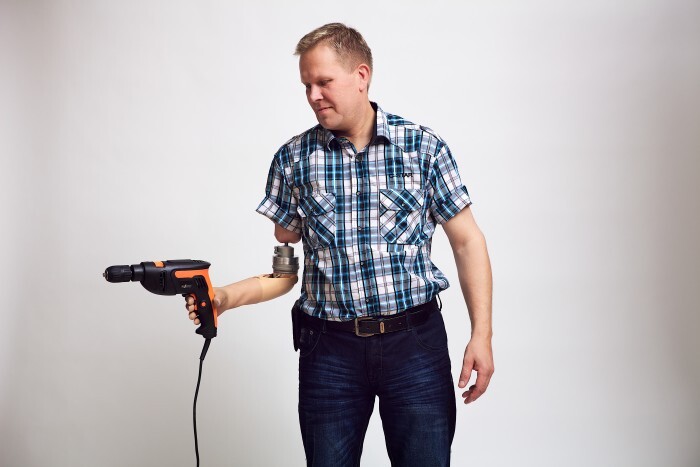Robotic prostheses have advanced greatly in the past decade, in terms of both cost and capability. Unfortunately, the standard electrode-over-skin method of control makes many of them unreliable and restricts their functionality, meaning that a number of recipients of these devices commonly reject them as a result. However, a Swedish man has recently celebrated a milestone in robotic prostheses by taking advantage of an osseointegrated (bone-anchored), thought-controlled, implant system in his daily life for more than a year and a half.
Gizmag previously reported on the initial pre-operative technology being developed for this operation by researchers at Sweden’s Chalmers University of Technology, where the prosthesis was developed. At the time, the team had hoped that the sophisticated algorithms within the artificial arm would give the subject finer control over movements than electrode-over-skin control had demonstrated. Given the efficacy claimed by the researchers in subsequent testing, this hope seems to have come to fruition.
In January 2013 the team at Chalmers University collaborated with Sahlgrenska University Hospital to surgically attach the limb. This involved attaching a titanium receptacle to the bone of the patient which then subsequently became fixed in place through osseointegration (where the titanium becomes fused permanently over a period of time). Following this procedure, an abutting component was attached to the titanium implant to act as a metallic bone extension to which the prosthesis was fixed.
As a result of their work, not only is the limb directly controllable from the signals from the patient's muscles, but the biometric connection also allows for signals to go the opposite way; from the artificial limb to the brain. And, even though the patient has a physically demanding occupation as a truck driver in northern Sweden, the artificial limb system has allowed him to lead a relatively normal life, coping with everything from operating machinery to connecting his trailer to his truck, to handling eggs or tying his shoelaces. In other words, the skeletally-fused artificial limb has proved almost as capable as his real arm.
"We have used osseointegration to create a long-term stable fusion between man and machine, where we have integrated them at different levels," said Max Ortiz Catalan, research scientist at Chalmers University of Technology. "The artificial arm is directly attached to the skeleton, thus providing mechanical stability. Then the human's biological control system, that is nerves and muscles, is also interfaced to the machine's control system via neuromuscular electrodes. This creates an intimate union between the body and the machine; between biology and mechatronics."
Using the osseointegrated technique means that there is no longer a socket required as in traditional artificial limb replacement. As a result, the patient experiences an augmented range of motion whilst enjoying the benefits of a more stable platform for their limb, along with easier attachment and detachment.
But, more than this, the recipient of this type of prosthesis also has heightened sensory feedback as a result of the direct transmission of forces and vibrations to the bone in a phenomenon known as osseoperception. Combined with the electrode-implanted biomuscular interface, the feedback and control experienced by the recipient means that they are able to interact more fully – and with much greater finesse – than they could with a traditional prosthetic replacement.

"Reliable communication between the prosthesis and the body has been the missing link for the clinical implementation of neural control and sensory feedback, and this is now in place," said Catalan. "So far we have shown that the patient has a long-term stable ability to perceive touch in different locations in the missing hand. Intuitive sensory feedback and control are crucial for interacting with the environment, for example to reliably hold an object despite disturbances or uncertainty. Today, no patient walks around with a prosthesis that provides such information, but we are working towards changing that in the very short term."
From an electronic point of view, the close proximity between the implant controls and electrodes in the muscles also diminishes the possibility of activity from other muscles interfering with signals, and – with more motor signals obtained directly from muscles and nerves (as compared to electrode-over-skin techniques) – more movements can be intuitively controlled in the prosthesis.
This also means that as the electrodes are implanted and protected from environmental interference, changes in temperature or misfirings from electromagnetic interference are largely negated, whilst electrodes implanted directly into the nerves may be used to send signals directly to the brain as felt sensations emanating from the prosthesis.
"We see this technology as an important step towards more natural control of artificial limbs," said Catalan. "It is the missing link for allowing sophisticated neural interfaces to control sophisticated prostheses. So far, this has only been possible in short experiments within controlled environments."
The researchers plan to help more amputees with this technology later this year.
The video below shows the Swedish man demonstrating the abilities of his prosthesis in various scenarios, with and without intramuscular electrode control.
The team's work was published in the journal Science Translational Medicine
Source: Chalmers University of Technology








